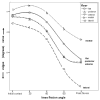The effect of an inclined landing surface on biomechanical variables during a jumping task
- PMID: 17826875
- PMCID: PMC2699559
- DOI: 10.1016/j.clinbiomech.2007.07.012
The effect of an inclined landing surface on biomechanical variables during a jumping task
Abstract
Background: Professional dancers sustain a high number of injuries. Epidemiological studies have suggested that performing on inclined "raked" stages increases the likelihood of injury. However, no studies have examined if biomechanical differences exist between inclined and flat surfaces during functional tasks, such as landing from a jump. Such differences may provide a biomechanical rationale for differences in injury risk for raked stages.
Methods: Eight professional dancers performed drop jumps from a 40cm platform on flat and inclined surfaces while forces, lower extremity kinematics, and electromyographic activity were collected in a controlled laboratory environment.
Findings: Dancers landed on the laterally inclined surface with significantly higher knee valgus (4 degrees ), peak knee flexion (9 degrees ), and medial-lateral ground reaction force (GRF) (13.4% body weight) compared to the flat condition. The posterior GRF was higher in the anterior inclined condition compared to the flat condition. In the anterior inclined condition, subjects landed with 1.4 degrees higher knee valgus, 4 degrees more plantarflexion at initial contact, and 3 degrees less dorsiflexion at the end of landing.
Interpretation: Biomechanical variables that have been suggested to contribute to injury in previous studies are increased in the inclined floor conditions. These findings provide a preliminary biomechanical rationale for differences in injury rates found in observational studies of raked stages.
Figures
Similar articles
-
The effects of floor incline on lower extremity biomechanics during unilateral landing from a jump in dancers.J Appl Biomech. 2012 May;28(2):192-9. doi: 10.1123/jab.28.2.192. J Appl Biomech. 2012. PMID: 22723117
-
The effects of "raked" stages on standing posture in dancers.J Dance Med Sci. 2008;12(2):54-8. J Dance Med Sci. 2008. PMID: 19618579 Clinical Trial.
-
Lower limb kinematic variability in dancers performing drop landings onto floor surfaces with varied mechanical properties.Hum Mov Sci. 2013 Aug;32(4):866-74. doi: 10.1016/j.humov.2013.07.009. Epub 2013 Aug 29. Hum Mov Sci. 2013. PMID: 23993251 Clinical Trial.
-
Peak Lower Extremity Landing Kinematics in Dancers and Nondancers.J Athl Train. 2018 Apr;53(4):379-385. doi: 10.4085/1062-6050-465-16. Epub 2018 Mar 12. J Athl Train. 2018. PMID: 29528687 Free PMC article.
-
Comparison of landing biomechanics between male and female dancers and athletes, part 2: Influence of fatigue and implications for anterior cruciate ligament injury.Am J Sports Med. 2014 May;42(5):1089-95. doi: 10.1177/0363546514524525. Epub 2014 Mar 4. Am J Sports Med. 2014. PMID: 24595401
Cited by
-
Prevalence and risk factors of musculoskeletal injuries in modern and contemporary dancers: a systematic review and meta-analysis.Front Public Health. 2024 Feb 28;12:1325536. doi: 10.3389/fpubh.2024.1325536. eCollection 2024. Front Public Health. 2024. PMID: 38481844 Free PMC article.
-
Comparative analysis of lower limb biomechanics during unilateral drop jump landings on even and medially inclined surfaces.PLoS One. 2025 May 2;20(5):e0322562. doi: 10.1371/journal.pone.0322562. eCollection 2025. PLoS One. 2025. PMID: 40315271 Free PMC article.
-
Anterior cruciate ligament injury and ankle dorsiflexion.Knee Surg Sports Traumatol Arthrosc. 2015 Nov;23(11):3202-7. doi: 10.1007/s00167-014-3123-1. Epub 2014 Jun 13. Knee Surg Sports Traumatol Arthrosc. 2015. PMID: 24923690
-
Neuromuscular characteristics of individuals displaying excessive medial knee displacement.J Athl Train. 2012 Sep-Oct;47(5):525-36. doi: 10.4085/1062-6050-47.5.10. J Athl Train. 2012. PMID: 23068590 Free PMC article.
-
Ankle dorsiflexion range of motion and landing postures during a soccer-specific task.PLoS One. 2023 Mar 16;18(3):e0283150. doi: 10.1371/journal.pone.0283150. eCollection 2023. PLoS One. 2023. PMID: 36928236 Free PMC article.
References
-
- Bendjaballah M, Shirazi-Adl A, Zukor D. Finite element analysis of human knee joint in varus-valgus. Clin Biomech. 1997;12:139–148. - PubMed
-
- Bronner S, Ojofeitimi S, Rose D. Injuries in a modern dance company: effect of comprehensive management on injury incidence and time loss. Am J Sports Med. 2003;31:365– 373. - PubMed
-
- Cerulli G, Benoit D, Caraffa A, Ponteggia F. Proprioceptive training and prevention of anterior cruciate ligament injuries in soccer. J Orthop Sports PhysTher. 2001;31:655–60. - PubMed
-
- Chappell J, Herman D, Knight B, Kirkendall D, Garrett W, Yu B. Effect of fatigue on knee kinetics and kinematics in stop-jump tasks. Am J Sports Med. 2005;33:1022–9. - PubMed
-
- Corrigan JP, Moore DP, Stephens MM. Effect of heel height on forefoot loading. Foot Ankle. 1993;14:148–52. - PubMed
MeSH terms
Grants and funding
LinkOut - more resources
Full Text Sources




